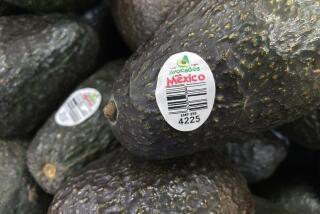Officials Defend 5% Sampling to Detect Poison
- Share via
WASHINGTON — Federal officials on Friday strongly defended the method they have chosen to ensure that fruit imported from Chile is safe, saying that a random sampling of 5% of the grapes and berries should be enough to detect any poison.
But many of the details of the inspection system must still be worked out and the fact remains that, even when the system finally is in place, 95% of the fruit will not be looked at by inspectors.
Ultimately, with grapes as with other food items, consumers will have to take some responsibility for ensuring the safety of what they eat. Consumers should watch out for “injection marks, unusual appearance, discoloration or chemical or almond-like smells” that would indicate the presence of cyanide, Food and Drug Administration Commissioner Frank E. Young said at a press conference Friday.
“I’ve been amazed how little time we spend looking at what we consume,” Young said. “Regretfully, we have been living possibly under the thought that everything is safe and wholesome without taking precautions.” That, he made clear, is no longer possible.
FDA tests performed over the last two weeks--since threats of poisoning were first raised--indicate that if cyanide is present in grapes, berries or other small acidic fruits, some signs should be apparent.
“One of the best things to look at in berries is for soft, overly ripe, mushy berries,” Young said. “I think most of us are in the habit of discarding those.”
But because the FDA does not yet know how cyanide would affect larger, less acidic fruits such as peaches and nectarines, those fruits will be kept out of the distribution system until further laboratory tests can be completed.
Such fruits are larger and presumably could hold more cyanide. In addition, because tree fruits are less acidic than grapes and berries, FDA scientists expect that cyanide in them would maintain its potency longer. In the presence of acids, sodium cyanide, the solid form of the poison, breaks down to form a gas, hydrogen cyanide, that would evaporate from the fruit.
Exactly how the new inspection system is to work remained unclear Friday as FDA officials, who had met with industry leaders until 2 a.m. Friday, continued a series of discussions over details. In general, however, the system is expected to work this way:
All fruit that has left Chile, whether it is currently on the high seas or aboard ships in ports or in customs warehouses, will be inspected on the docks in the United States. Inspectors will look at 5% of the crates on every shipment, or at least 15,000 crates per ship. If they see any suspicious-looking fruit in those crates, that fruit will be taken to a laboratory for analysis. In the meantime, the fruit will be impounded.
Fruit still in Chile will be inspected there, also at a rate of 5% per shipment, with a minimum of 15,000 crates per ship. FDA personnel will be sent to Chile to examine the inspection system. Once the FDA is convinced that the Chilean system is working properly, the intensive inspections in the United States will cease. The FDA does not yet know how long that will take.
Maximum Level
The 5% inspection level, Young said, is “the maximum feasible” given the resources available and the amount of time needed to unload fruit from a ship before it begins to spoil. But it also is a considerably higher rate of sampling, he noted, than most other consumer products get.
“The United States,” he said, “has had a substantial sampling experience,” and FDA officials believe that 5% will be sufficient to detect any tampering with fruit.
Who will do the inspections remained somewhat unclear Friday. Agriculture Secretary Clayton K. Yeutter said that his agency will assist the FDA and provide 100 to 200 inspectors. But the department has not yet determined “how we can assist them and when and where they want us to do this,” USDA spokesman Bob Melland said.
According to industry officials, the vast majority of the inspectors will be employees of the companies that import Chilean fruit and will be paid by them, not the taxpayer. The FDA will audit the work of those inspectors to ensure that they are doing the job properly.
Similar cooperative inspection programs are routinely used to screen medical devices, drugs and other food items for safety, but their effectiveness often has been questioned.
This weekend, the FDA hopes to begin training the new inspectors. Once the work force is trained, the new, intensive inspections will begin and Chilean produce will start reappearing on grocers’ shelves. That process could take as long as five to nine days, Young said.
More to Read
Sign up for Essential California
The most important California stories and recommendations in your inbox every morning.
You may occasionally receive promotional content from the Los Angeles Times.














